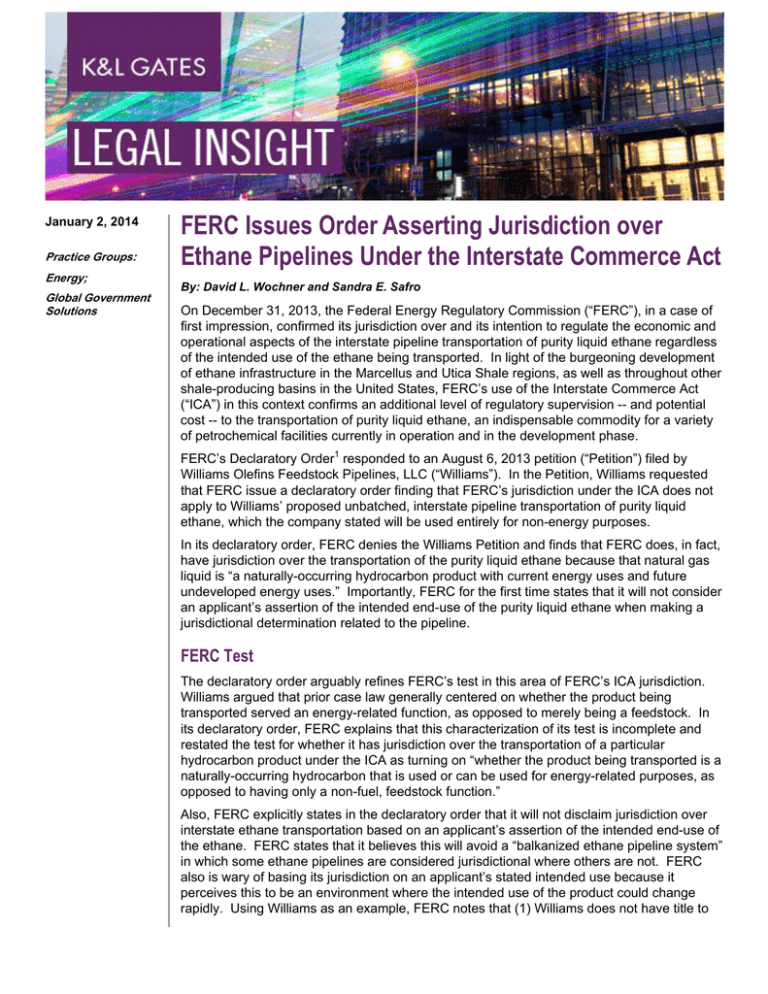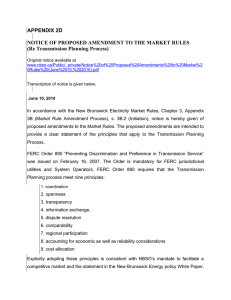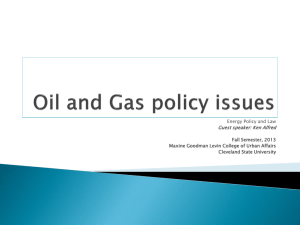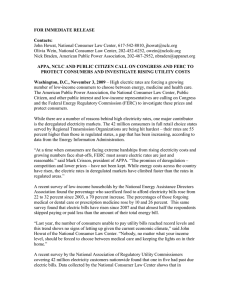
January 2, 2014
Practice Groups:
Energy;
Global Government
Solutions
FERC Issues Order Asserting Jurisdiction over
Ethane Pipelines Under the Interstate Commerce Act
By: David L. Wochner and Sandra E. Safro
On December 31, 2013, the Federal Energy Regulatory Commission (“FERC”), in a case of
first impression, confirmed its jurisdiction over and its intention to regulate the economic and
operational aspects of the interstate pipeline transportation of purity liquid ethane regardless
of the intended use of the ethane being transported. In light of the burgeoning development
of ethane infrastructure in the Marcellus and Utica Shale regions, as well as throughout other
shale-producing basins in the United States, FERC’s use of the Interstate Commerce Act
(“ICA”) in this context confirms an additional level of regulatory supervision -- and potential
cost -- to the transportation of purity liquid ethane, an indispensable commodity for a variety
of petrochemical facilities currently in operation and in the development phase.
FERC’s Declaratory Order1 responded to an August 6, 2013 petition (“Petition”) filed by
Williams Olefins Feedstock Pipelines, LLC (“Williams”). In the Petition, Williams requested
that FERC issue a declaratory order finding that FERC’s jurisdiction under the ICA does not
apply to Williams’ proposed unbatched, interstate pipeline transportation of purity liquid
ethane, which the company stated will be used entirely for non-energy purposes.
In its declaratory order, FERC denies the Williams Petition and finds that FERC does, in fact,
have jurisdiction over the transportation of the purity liquid ethane because that natural gas
liquid is “a naturally-occurring hydrocarbon product with current energy uses and future
undeveloped energy uses.” Importantly, FERC for the first time states that it will not consider
an applicant’s assertion of the intended end-use of the purity liquid ethane when making a
jurisdictional determination related to the pipeline.
FERC Test
The declaratory order arguably refines FERC’s test in this area of FERC’s ICA jurisdiction.
Williams argued that prior case law generally centered on whether the product being
transported served an energy-related function, as opposed to merely being a feedstock. In
its declaratory order, FERC explains that this characterization of its test is incomplete and
restated the test for whether it has jurisdiction over the transportation of a particular
hydrocarbon product under the ICA as turning on “whether the product being transported is a
naturally-occurring hydrocarbon that is used or can be used for energy-related purposes, as
opposed to having only a non-fuel, feedstock function.”
Also, FERC explicitly states in the declaratory order that it will not disclaim jurisdiction over
interstate ethane transportation based on an applicant’s assertion of the intended end-use of
the ethane. FERC states that it believes this will avoid a “balkanized ethane pipeline system”
in which some ethane pipelines are considered jurisdictional where others are not. FERC
also is wary of basing its jurisdiction on an applicant’s stated intended use because it
perceives this to be an environment where the intended use of the product could change
rapidly. Using Williams as an example, FERC notes that (1) Williams does not have title to
FERC Issues Order Asserting Jurisdiction over Ethane
Pipelines Under the Interstate Commerce Act
the ethane in its pipeline, so Williams cannot be certain of the ultimate use of the ethane it
transports; and (2) some of the ethane Williams delivers will be placed into storage from
which the product could be delivered to serve a variety of energy purposes.
Additional Points
In analyzing the Petition under this test, FERC rejects the assertion that, although purity
liquid ethane theoretically could be burned, the product’s practical or commercial use is not
an energy or fuel use. Instead, FERC focuses on several current energy uses for purity
ethane, as well as future undeveloped energy uses for the product. It is worth noting that
FERC restates and confirms that it has disclaimed jurisdiction over the transportation by
pipeline of anhydrous ammonia, polymer-grade propylene, and chemical-grade propylene.
Next Steps
Under FERC regulations, Williams will have 30 days from the date of the declaratory order to
file a request for rehearing with FERC, which is a prerequisite to filing an appeal in federal
court. No other entities intervened in the proceeding and, therefore, Williams is the only
entity that will have a legal right to file such a request.
Authors:
David L. Wochner
david.wochner@klgates.com
+1.202.778.9014
Sandra E. Safro
sandra.safro@klgates.com
+1.202.778.9178
2
FERC Issues Order Asserting Jurisdiction over Ethane
Pipelines Under the Interstate Commerce Act
Anchorage Austin Beijing Berlin Boston Brisbane Brussels Charleston Charlotte Chicago Dallas Doha Dubai Fort Worth Frankfurt
Harrisburg Hong Kong Houston London Los Angeles Melbourne Miami Milan Moscow Newark New York Orange County Palo Alto Paris
Perth Pittsburgh Portland Raleigh Research Triangle Park San Diego San Francisco São Paulo Seattle Seoul Shanghai Singapore Spokane
Sydney Taipei Tokyo Warsaw Washington, D.C. Wilmington
K&L Gates practices out of 48 fully integrated offices located in the United States, Asia, Australia, Europe, the Middle East and South
America and represents leading global corporations, growth and middle-market companies, capital markets participants and
entrepreneurs in every major industry group as well as public sector entities, educational institutions, philanthropic organizations and
individuals. For more information about K&L Gates or its locations, practices and registrations, visit www.klgates.com.
This publication is for informational purposes and does not contain or convey legal advice. The information herein should not be used or relied upon in
regard to any particular facts or circumstances without first consulting a lawyer.
©2013 K&L Gates LLP. All Rights Reserved.
1
Williams Olefins Feedstock Pipelines, LLC, 145 FERC ¶ 61,303 (2013).
3




